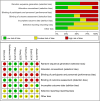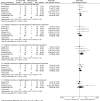No difference between CT- and MRI-based patient-specific instrumentation for total knee arthroplasty: an updated systematic review and meta-analysis
- PMID: 40771726
- PMCID: PMC12325346
- DOI: 10.3389/fbioe.2025.1624600
No difference between CT- and MRI-based patient-specific instrumentation for total knee arthroplasty: an updated systematic review and meta-analysis
Abstract
Object: Our previous systematic review of either computed tomography (CT)-based or magnetic resonance imaging (MRI)-based patient-specific instrumentation (PSI) systems in total knee arthroplasty (TKA) included literature up to June 2016. However, the quickly evolving field warranted an update. Therefore, the aim of this systematic review and meta-analysis was to provide updated, evidence-based insights comparing the outcomes of CT-based versus MRI-based PSI systems in TKA.
Methods: We conducted comprehensive searches of PubMed, Embase, and the Cochrane Library databases from inception to February 2025. Prospective comparative trials that compared CT-based versus MRI-based PSI systems for TKA were included. Our predefined primary outcome was the incidence of outliers in overall coronal limb alignment. Secondary outcomes encompassed the accuracy of component alignment, operation time, and clinical outcomes.
Results: Nine publications reporting seven eligible trials were identified. Six trials involving a total of 407 knees were included for qualitative analysis, with five trials suitable for quantitative meta-analysis. The integrated results revealed no significant differences between CT- and MRI-based PSI systems concerning the outlier incidence of coronal overall limb alignment, the outlier incidence of coronal/sagittal alignment of the femoral/tibial component, the angular errors of coronal overall limb alignment, the angular errors of the femoral/tibial component in the coronal plane, or incidence of change of implant size of the femoral/tibial component. However, CT-based PSI systems were associated with significantly greater angular errors in coronal limb alignment (mean difference [MD]: 0.69°; 95% CI, 0.03°-1.36°; P = 0.04) and a prolonged operative time (MD: 5.02 min; 95% CI, 1.26min-8.79 min; P = 0.009) when compared to MRI-based systems. Clinical outcomes, while not amenable to meta-analysis due to clinical heterogeneity, showed no significant differences between groups during short-to mid-term follow-up.
Conclusion: This finding is inconsistent with our previous study. Contrary to our previous findings, current evidence indicates no significant difference in alignment outcomes between CT-based and MRI-based PSI systems for TKA. Additionally, short-to mid-term clinical outcomes were comparable between the two imaging modalities.
Systematic review registration: identifier CRD42022339910.
Keywords: alignment; computed tomography; magnetic resonance imaging; patient-specific instrumentation; total knee arthroplasty.
Copyright © 2025 Shao, Wu, Liu, Wang, Li, Tao and Wang.
Conflict of interest statement
The authors declare that the research was conducted in the absence of any commercial or financial relationships that could be construed as a potential conflict of interest.
Figures







Similar articles
-
CT- versus MRI-based patient-specific instrumentation for total knee arthroplasty: A systematic review and meta-analysis.Surgeon. 2017 Dec;15(6):336-348. doi: 10.1016/j.surge.2017.06.002. Epub 2017 Jul 26. Surgeon. 2017. PMID: 28756064
-
Favourable alignment outcomes with MRI-based patient-specific instruments in total knee arthroplasty.Knee Surg Sports Traumatol Arthrosc. 2018 Sep;26(9):2659-2668. doi: 10.1007/s00167-017-4637-0. Epub 2017 Jul 11. Knee Surg Sports Traumatol Arthrosc. 2018. PMID: 28698929
-
Accuracy of MRI-based vs. CT-based patient-specific instrumentation in total knee arthroplasty: A meta-analysis.J Orthop Sci. 2017 Jan;22(1):116-120. doi: 10.1016/j.jos.2016.10.007. Epub 2016 Nov 4. J Orthop Sci. 2017. PMID: 27823847
-
Mobile bearing vs fixed bearing prostheses for posterior cruciate retaining total knee arthroplasty for postoperative functional status in patients with osteoarthritis and rheumatoid arthritis.Cochrane Database Syst Rev. 2015 Feb 4;2015(2):CD003130. doi: 10.1002/14651858.CD003130.pub3. Cochrane Database Syst Rev. 2015. PMID: 25650566 Free PMC article.
-
Are There Differences in Accuracy or Outcomes Scores Among Navigated, Robotic, Patient-specific Instruments or Standard Cutting Guides in TKA? A Network Meta-analysis.Clin Orthop Relat Res. 2020 Sep;478(9):2105-2116. doi: 10.1097/CORR.0000000000001324. Clin Orthop Relat Res. 2020. PMID: 32530896 Free PMC article.
References
Publication types
LinkOut - more resources
Full Text Sources

